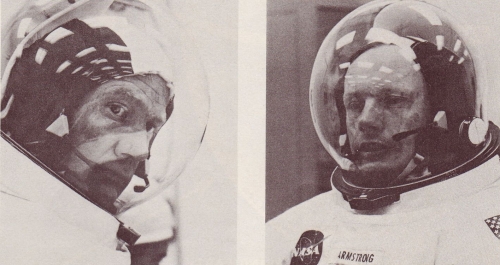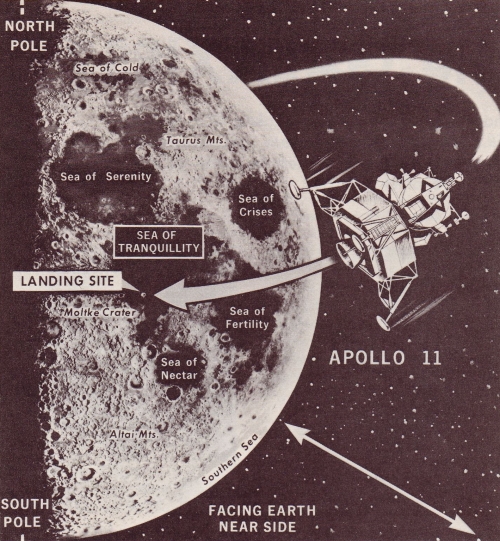Prepare for a shock!
The answer is an absolute NO!
Mortal man WILL NEVER get outside his immediate solar neighborhood — NEVER get out
to the limits of his own galaxy or to other galaxies.
TO MAKE such statements as "can't" and "never" and "impossible" where science is concerned is to invite immediate sneers and scoffs of pity.
|
With the almost completely unbelievable achievements of America's Apollo 11 mission — the actual lunar landing and moonwalk — the collecting of lunar samples — millions are convinced NOTHING is impossible with man, now.
Dream of it, speculate about it, add money and science, and it will come to pass. Or so millions think.
The magic formula is as simple as turning on a TV set — even if those same millions have not the slightest notion about what makes the set work. Just dream of some completely unimaginable feat — add enough money and enough scientists, and wait until the networks tell you when the spectacle is scheduled for viewing.
|
NASA Photos

FIRST TWO MEN TO WALK ON MOON — American astronauts
Neil A. Armstrong, right, and Edwin E. Aldrin, Jr.
|
What's This — Heresy Against Science?
To doubt the ability of science today is to conjure up visions of skeptical onlookers at Fulton's steamboat, or the people jeering at the dock when Columbus waved good-by.
To seriously question the limits of man's scientific conquests is to appear guilty of some terrible heresy — some shocking denial of the faith.
To the millions sitting glued to their TV sets, watching two Americans cavort with easy strides on the lunar surface, this was as impressive as seeing fire come down from heaven — with your own eyes.
Millions said, as if with one voice, "I can't believe it!" "Fantastic!" "Impossible!" Words spoken, almost reverently, as the greatest "death-defying leap" in the history of man-made spectaculars was enacted before half a billion human beings.
To question the final limits of man in space at this point is to seem irreligious, somehow. But maybe you should read on.
No Trespassing Signs Out There
Heretical as it may sound — there are limits upon us. Man is still LIMITED. So far, we have been operating within those limitations; but accomplishing feats of technology which are breathtakingly impressive. So much so that millions have been caught up in a scientific spell as if captured by the magic of the stentorian voice of the traveling medicine man with his sure-cure, sure-fire snake elixir guaranteed to fix whatever ails you. To doubt now is simple heresy. Or so many believe.
But man is limited.
Today, we are reaching almost to the walls about us — almost ready to touch the bounds which constrain us. But, like someone exploring his environment who has not yet discovered the high wall hidden by the climbing vines, mankind has not yet discovered the finality of his environmental confines. There is a wall beyond which we cannot go. There is a point out there beyond which only impossibility lies.
You doubt limits? You disbelieve?
If man is absolutely accurate in his measurements — light is observed to travel at the speed (through a vacuum) of 186,281 miles each second.
|
Wide World
 |
And that is the utter limit. Beyond this, there is nothing else where speed is concerned. This is the ultimate in speed for physical objects — an ultimate imposed by the laws of the universe itself, by the laws which man did not invent, produce, nor even properly define.
Nothing is known, or can come to be known, which is faster than the speed with which light travels.
Perhaps you will balk at reading this — say to yourself "everything is constantly changing," or "they'll soon find something faster." And this, itself, proves one of the basic premises of this article — that the sublime dedication, now, to science, surpasses in many cases the near-hypnotic trances of many a savage caught up in the voodoo of a parading witch doctor.
I speak not only of the dedication of some (though by no means all) scientists — but mainly of the layman.
People like to believe scientists need only more time, money and ingenuity — after which literally NOTHING is impossible. And in this is the stuff of which religious faith consists.
But scientists are limited by the very laws of the universe. They are bound by laws. Science does not create or produce those laws — it often finds itself lacking clear definitions for them — and scientists must operate within the absolutes of powerful forces which are far beyond science.
The reason many people find such limits hard to accept in this modern age is because most people are not scientists. Many a layman has found himself in awe of fairly simple scientific experiments. How much more, then, the open-mouthed admiration at a lunar walk? And a lunar walk is to be admired — don't misunderstand. The incredible courage, training and performance of U.S. spacemen is impressive beyond adjectives. But there are limits, nevertheless.
What are they?
|
|
Artist's conception of the July Apollo 11 lunar module landing of Armstrong and Aldrin in the "Sea of Tranquillity." Lunar module is composed of ascent and descent stages. Upon lift-off from moon the descent stage is left behind. Only ascent stage, housing astronauts, left the moon, then docked with mother ship circling the moon. Ascent stage was later jettisoned.
|
Speed is one. As already mentioned, there is a "light barrier" built into our universe which is like a universal "speed limit" law. Beyond it, no additional speed is possible.
The speed of light is the final limit — beyond this, nothing.
No material, man-made object (or any other object, for that matter) can even approach that speed — let alone surpass it. And this admits no speculation, or argument, or denials. This is fact. Not "scientific" fact in the sense that man has discovered, defined or created such a "fact," but incontrovertible, immutable FACT of the universe. It is simply the way things are.
Why can't anything reach or surpass the speed of light?
Because of the way the universe itself is constructed. It takes an inertial push to move an object. At the launch of Apollo 11 (I witnessed this fabulous sight from Cape Kennedy), the Saturn V moon vehicle was given inertial push of up to 7.5 million pounds of thrust.
As the spaceship accelerated, it also grew ever heavier (or "more massive").
At slower speeds, with which most humans are familiar, the proportion of speed that goes into mass is so tiny it is ignored.
But it is a LAW of the universe that, the higher the velocity, the larger the percentage of the acceleration (push) that is converted into mass, and the smaller the percentage of acceleration that moves the object. There is a final point of acceleration beyond which it is physically impossible to accelerate — and that is the speed of light.
This is a FACT of the UNIVERSE — not just "speculation" of science.
Of course, the idea of pushing any material object to even the remotest speed close to light is in itself in the area of sheer fantasy — but even if this would be remotely possible, there is nothing beyond.